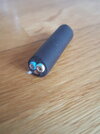Glad you agree. Indeed, even if one didn't (agree), the present regulation, as written, seems totally daft, since it contains no requirement for fire 'containment' - provided only that what material is left is 'non-combustible', the front, sides and bottom of the enclosure can be covered in ~12mm diameter holes and remain 'compliant'!I can only agree with all of this. The emboldened is actually an 'old chestnut' of mine too (and why none of mine at home have been changed to metal) ....
That's up to you - but, as for me, if I stick with plastic CUs because my personal view is that metal CUs would not appreciably protect me from fire, but may expose me to increased risk of electric shock, it doesn't seem particularly 'right' that I should have less concern for the safety of tenants (if there were any) than myself.but regardless I have to keep up with the times/fashion ...
Good question. As I've been saying from the start, I'm sure that it is "only a matter of time" (if it hasn't happened already before some such tragedies occur, and the LFB will seemingly have that on their conscience!and who knows what's going to happen in 10 yeaars when there have been too many metal box electrocutions?
As for "what's going to happen", goodness only knows - quite probably 'nothing', I suppose. The present reg does not, of course, explicitly require metal, so it would not be impossible to change the requirement to "non-combustible (if they must!
Kind Regards, John


